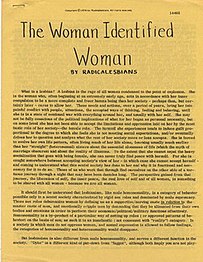
Back The Woman-Identified Woman AST The Woman-Identified Woman Spanish The Woman-Identified Woman French Женщина, идентифицируемая женщиной Russian

| Part of a series on |
| Feminism |
|---|
 |
|
|
"The Woman-Identified Woman" was a ten-paragraph manifesto, written by the Radicalesbians in 1970.[1] It was first distributed during the Lavender Menace protest at the Second Congress to Unite Women, hosted by the National Organization for Women (NOW) on May 1, 1970, in New York City in response to the lack of lesbian representation at the congress.[2] It is now considered a turning point in the history of radical feminism and one of the founding documents of lesbian feminism redefining the term "lesbian" as a political identity as well as a sexual one.
It was written by a group of lesbian radical feminists who formed the group Radicalesbians or, originally, the Lavender Menace. The authors consisted of Artemis March, Lois Hart, Rita Mae Brown, Ellen Shumsky, Cynthia Funk, and Barbara XX. It was edited by Artemis March. A group of lesbian radical feminists staged a "zap" for the opening session of the Congress, during which they cut the lights, took over the stage and microphone and denounced the exclusion of lesbian speakers at the Congress. They distributed mimeographed copies of "The Woman-Identified Woman", in which they argued that lesbians are at the forefront of the struggle for women's liberation because their identification with other women defies traditional definitions of women's identity in terms of male sexual partners, and expressed, "...the primacy of women relating to women, of women creating a new consciousness of and with each other which is at the heart of women's liberation, and the basis for the cultural revolution." At the following NOW conference, held in New York City in September 1971, the Congress adopted a resolution acknowledging the rights of lesbians as a "legitimate concern for feminism".[3]
- ^ Faderman, Lillian (2015). The Gay Revolution: The Story of the Struggle. Simon & Schuster.
- ^ Weiss, Penny (2018). Feminist Manifestos : A Global Documentary Reader (1 ed.). New York University Press. pp. 221–222. ISBN 9781479805419.
- ^ Iovannone, Jeffry J. (2018-06-04). "Rita Mae Brown: Lavender Menace". Queer History For the People. Retrieved 2019-02-11.